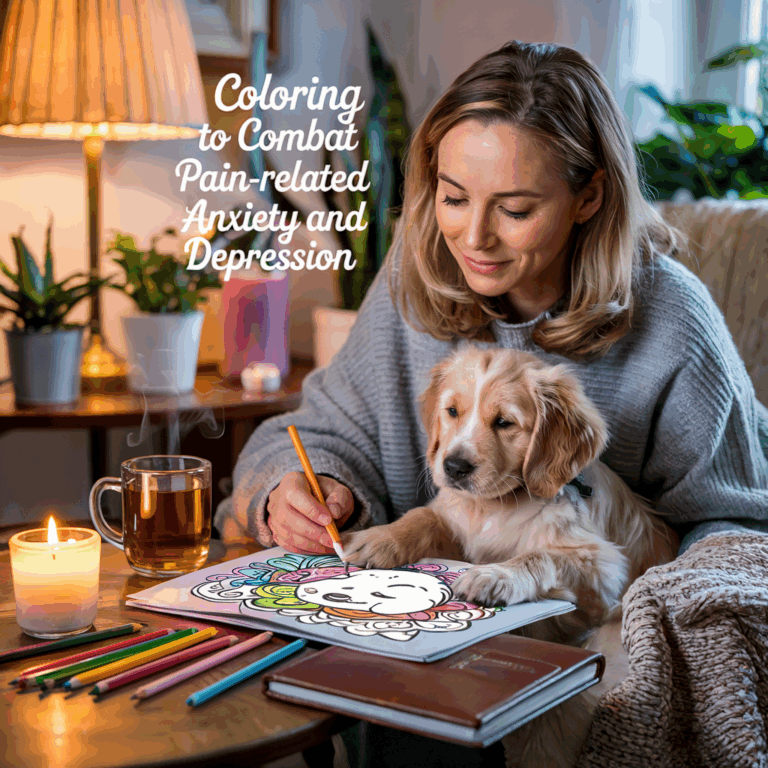Discover How This Simple Activity Can Reduce Stress, Boost Creativity, and Improve Mental Health
Mindful coloring is more than just filling in shapes with color. It’s a powerful stress-relieving practice that promotes relaxation, focus, and creativity. But what makes it so effective?
In this blog post, we’ll explore the science behind mindful coloring, its incredible benefits, and how you can use it to transform your daily life. Whether you want to manage anxiety, improve concentration, or unwind, mindful coloring is an easy and enjoyable way to achieve peace of mind.
What Is Mindful Coloring?
Mindful coloring is a creative activity that allows you to focus on the present moment while engaging in a relaxing, repetitive task. It’s a form of active meditation where your mind can release stress and enjoy creating.
Unlike traditional coloring, mindful coloring encourages you to immerse yourself fully in the experience. The goal isn’t perfection—it’s about enjoying the act of coloring itself.
Many people compare mindful coloring to deep breathing exercises or guided meditation. It slows racing thoughts, calms the nervous system, and helps you stay present.
The Science Behind Mindful Coloring
How Coloring Affects the Brain
Research has shown that coloring activates the same brain areas as meditation. This helps shift the mind from a state of stress to calmness.
Here’s how it works:
- Engages the Prefrontal Cortex – Coloring requires focus and decision-making, which stimulates the prefrontal cortex, the part of the brain responsible for reasoning and problem-solving.
- Reduces the Amygdala’s Activity – The amygdala is the part of the brain that triggers stress and anxiety. Coloring helps lower its activity, leading to relaxation.
- Boosts Dopamine Levels – Completing a coloring page gives a sense of accomplishment, which triggers the release of dopamine, the brain’s “feel-good” hormone.
Dr. Stan Rodski, a neuroscientist, has studied the effects of mindful coloring on the brain. His research found that coloring lowers heart rate, improves focus, and creates a meditative state.
5 Powerful Benefits of Mindful Coloring
1. Reduces Stress and Anxiety
When life gets overwhelming, mindful coloring offers a simple way to relax. The rhythmic, repetitive motion of coloring slows down the mind and eases tension.
A 2016 study in Art Therapy: Journal of the American Art Therapy Association found that just 20 minutes of coloring reduces anxiety levels. It works similarly to meditation by shifting focus away from worries.
2. Enhances Focus and Concentration
Coloring requires attention to patterns, colors, and details, strengthening focus. Because of this, it’s often used as a brain-training exercise to improve cognitive function.
Spending time on mindful coloring can help boost productivity, improve memory, and train the brain to stay present.
3. Encourages Creativity Without Pressure
Unlike painting or drawing, coloring doesn’t require advanced artistic skills, making it a judgment-free creative outlet for anyone.
Choosing colors, blending shades, and experimenting with patterns stimulates the creative side of the brain, helping to boost problem-solving skills and imaginative thinking.
4. Promotes Mindfulness and Mental Clarity
Mindfulness is the practice of being fully engaged in the present moment. Coloring helps achieve this state by directing attention to simple, repetitive actions.
Instead of worrying about the past or future, your mind stays calm and focused on the page before you.
5. Provides a Screen-Free Break for Mental Well-Being
We live in a world filled with constant notifications, emails, and social media. Mindful coloring offers a much-needed break from screens and allows the brain to reset.
Taking time away from digital distractions improves sleep, reduces eye strain, and promotes relaxation.
How to Get Started with Mindful Coloring
1. Choose a Coloring Book That Speaks to You
Not all coloring books are the same! Pick one with designs that bring you joy. Whether it’s mandalas, nature scenes, or adorable puppies, selecting the right theme enhances the experience.
Find a selection of beautiful, stress-relieving coloring books at MaxwellPawsworth.com.
2. Gather Your Coloring Supplies
All you need to get started are:
✔️ Colored pencils, markers, or gel pens
✔️ A comfortable, quiet space
✔️ Soft lighting and calming music (optional)
3. Set Aside Time for Coloring
Even 10–20 minutes a day can significantly impact stress levels. Try making coloring a part of your morning or bedtime routine.
4. Focus on the Process, Not the End Result
Mindful coloring is about the journey, not the outcome. Let go of perfectionism and enjoy the simple act of creating.
If your mind wanders, gently bring your focus back to the colors and patterns.
The Future of Mindful Coloring
Mindful coloring is not just a passing trend. With proven benefits for mental health, focus, and creativity, it’s a practice that continues to grow in popularity.
More workplaces, schools, and therapy centers are integrating coloring into wellness programs. Its accessibility and simplicity make it an easy tool for people of all ages.
As more people experience the transformative power of mindful coloring, the future looks brighter and more colorful.
Final Thoughts
Mindful coloring is a powerful yet simple way to relax, focus, and express creativity. Whether you’re seeking stress relief, a screen-free escape, or a way to practice mindfulness, coloring can provide a calming and enjoyable experience.
Ready to unlock the benefits of mindful coloring? Explore beautifully designed adult coloring books at MaxwellPawsworth.com and start your journey to relaxation today.
Give yourself the gift of creativity and mindfulness—one page at a time.







